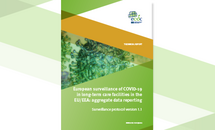Core protocol for ECDC studies of COVID-19 vaccine effectiveness against hospitalisation with Severe Acute Respiratory Infection, laboratory-confirmed with SARS-CoV-2 or with seasonal influenza - Version 2.0
This core protocol for ECDC studies of vaccine effectiveness against hospitalisation with Severe Acute Respiratory Infection laboratory-confirmed with SARS-CoV-2 or with influenza, version 2.0, represents an update to the main elements for a multi-country hospital-based study of COVID-19 vaccine effectiveness in patients hospitalised with Severe Acute Respiratory Infection (SARI), already published as version 1.0.
Executive summary
The end of 2019 saw the emergence of a novel severe acute respiratory syndrome coronavirus 2 (SARS-CoV-2) causing coronavirus disease 2019 (COVID-19). As of week 39, 2022, over 168 million cases and more than 1.1 million deaths had been reported in the European Union/European Economic Area (EU/EEA) [1]. As of December 2022, seven vaccines had been authorised by the European Commission based on the scientific opinion of the European Medicines Agency (EMA) for use in the European Union (Comirnaty, COVID-19 Vaccine Valneva, Nuvaxovid [previously Novavax], Spikevax [previously COVID-19 vaccine Moderna], Vaxzevria [previously AstraZeneca], and Jcovden [previously Covid-19 Vaccine Janssen] and VidPrevtyn Beta (indicated as a booster)) and three adapted vaccines had been authorised as boosters (Comirnaty Original/Omicron BA.1, Comirnaty Original/Omicron BA.4-5, Spikevax bivalent Original/Omicron BA.1). Many other vaccines are under rolling review.
Influenza viruses undergo frequent genetic and antigenic changes. The influenza vaccine is reformulated each year and annual re-vaccination is recommended. Observed influenza vaccine effectiveness (IVE) varies from year to year between population sub-groups (age groups, risk groups) and differs for the various influenza types, subtypes and genetic clades, and outcomes measured. Immunological correlates of protection are not well defined. In 2017, the European Medicines Agency (EMA) formally adopted new guidelines on influenza vaccines covering, inter alia, post-authorisation
studies of vaccine effectiveness, including brand-specific IVE data.
The available vaccine products currently in use for EU/EEA immunisation programmes, the target groups for vaccination and the vaccination coverage all vary across countries. New vaccines are being developed for which limited or no effectiveness data are yet available in the EU. A comparison by vaccine type (adjuvanted vs nonadjuvanted, live attenuated vs inactivated, egg- vs cell-based), group (split virion, subunit, etc.) and product could provide essential information for vaccine recommendations and health economic assessments.
In 2020, the European Commission stressed the importance of continuously monitoring the safety and
effectiveness of vaccines in the EU/EEA in the post-authorisation phase, with particular emphasis on COVID-19 vaccines in the context of the ongoing pandemic. The 2018 ‘Council Recommendation on Strengthened Cooperation against Vaccine-preventable Diseases’ already called on ECDC and EMA to cooperate to ensure the continued monitoring of vaccines and vaccination in use in EU/EEA vaccination programmes. This request was subsequently formalised as part of the extended EMA regulatory mandate and ECDC’s newly amended mandate, requiring the two Agencies to develop a structured and independent post-authorisation vaccine monitoring platform, initially prioritising COVID-19 vaccines. ECDC and EMA officially established and launched the platform in May 2022, with the intention of bringing together public health and regulatory experts to discuss the studies needed to generate real-life evidence on the safety and effectiveness of vaccines in use in EU/EEA immunisation programmes.
ECDC already began building infrastructure to perform COVID-19 vaccine effectiveness (CVE) studies in 2020, using the lessons learned from other vaccine effectiveness studies. The infrastructure will be used to build a system that regularly monitors vaccine effectiveness and performs studies, including impact and burden of disease studies, in different settings. Depending on the setting, information will be provided on different outcomes (severe disease, moderate disease, transmission, etc). The overall project is called VEBIS (Vaccine Effectiveness, Burden and Impact Studies) and it includes different networks of study sites/countries/infrastructures, where the multi-country studies are conducted.
This core protocol for ECDC studies of vaccine effectiveness against hospitalisation with Severe Acute Respiratory Infection laboratory-confirmed with SARS-CoV-2 or with influenza, version 2.0, represents an update to the main elements for a multi-country hospital-based study of COVID-19 vaccine effectiveness in patients hospitalised with Severe Acute Respiratory Infection (SARI), already published as version 1.0 [8]. This version includes a section on influenza vaccine effectiveness, outlining the agreed methods for collecting data related to SARS-CoV-2 and influenza infections at country level, and including a plan for pooled analyses. The larger sample size achieved by combining data from multiple sites will provide more statistical power to meet more specific objectives. The protocol can be implemented for COVID-19 and/or influenza.
The proposed method is a case-control study using a test negative design. The study population consists of individuals of all ages, belonging to the target group for COVID-19 or influenza vaccination, hospitalised with SARI symptoms and no contra-indication for being vaccinated with the vaccine of interest. The study period runs during the influenza circulation season for influenza vaccine effectiveness study. It would be beneficial if those countries only measuring vaccine effectiveness (VE) for COVID-19 also test for influenza during the influenza season, as well as for all other respiratory viruses (as appropriate depending on time of year).
This core protocol is primarily intended to guide the implementation of ECDC-funded studies. However, ECDC encourages the conduct of vaccine effectiveness studies, using this protocol as a basis, in countries not currently planning to participate in ECDC-funded studies. The use of consistent protocols will facilitate the comparability of study results across studies, countries and study sites.
This document represents version 2.0 of the core protocol, and succeeds version 1.0, which has already been adapted and implemented at country level. Results from the implementation of the VEBIS multi-country study from version 1 are available publicly on ECDC’s website. This document and its country-level adaptations will continue to be updated and revised on a regular basis.







